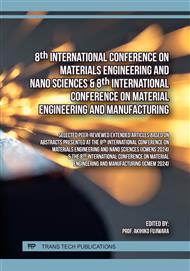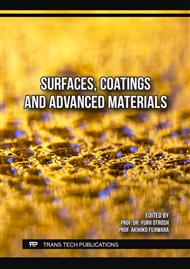[1]
L. Xiong et al., "Size-controlled synthesis of Cu2O nanoparticles: Size effect on antibacterial activity and application as a photocatalyst for highly efficient H2O2 evolution," RSC Adv, vol. 7, no. 82, p.51822–51830, 2017.
DOI: 10.1039/c7ra10605j
Google Scholar
[2]
Y. H. Zhang, M. M. Liu, J. L. Chen, S. M. Fang, and P. P. Zhou, "Recent advances in Cu2O-based composites for photocatalysis: a review," Dalton Transactions, vol. 50, no. 12, p.4091–4111, 2021.
DOI: 10.1039/d0dt04434b
Google Scholar
[3]
T. Maxwell, M. G. Nogueira Campos, S. Smith, M. Doomra, Z. Thwin, and S. Santra, Quantum dots. Elsevier Inc., 2019.
DOI: 10.1016/B978-0-12-816662-8.00015-1
Google Scholar
[4]
K. Tungare, M. Bhori, K. S. Racherla, and S. Sawant, "Synthesis, characterization and biocompatibility studies of carbon quantum dots from Phoenix dactylifera," 3 Biotech, vol. 10, no. 12, Dec. 2020.
DOI: 10.1007/s13205-020-02518-5
Google Scholar
[5]
Y. Wang et al., "Cuprous oxide nanoparticles selectively induce apoptosis of tumor cells," Int J Nanomedicine, vol. 7, p.2641–2652, 2012.
DOI: 10.2147/IJN.S31133
Google Scholar
[6]
A. Kausar, "Polyacrylonitrile-based nanocomposite fibers: A review of current developments," Journal of Plastic Film and Sheeting, vol. 35, no. 3, p.295–316, 2019.
DOI: 10.1177/8756087919828151
Google Scholar
[7]
M. Hashmi, S. Ullah, and I. S. Kim, "Copper oxide (CuO) loaded polyacrylonitrile (PAN) nanofiber membranes for antimicrobial breath mask applications," Curr Res Biotechnol, vol. 1, p.1–10, 2019.
DOI: 10.1016/j.crbiot.2019.07.001
Google Scholar
[8]
F. Ebrahimi, S. R. Nabavi, and A. Omrani, "Fabrication of hydrophilic hierarchical PAN/SiO2 nanofibers by electrospray assisted electrospinning for efficient removal of cationic dyes," Environ Technol Innov, vol. 25, p.102258, 2022.
DOI: 10.1016/j.eti.2021.102258
Google Scholar
[9]
M. E. Aguirre, R. Zhou, A. J. Eugene, M. I. Guzman, and M. A. Grela, "Cu2O/TiO2 heterostructures for CO2 reduction through a direct Z-scheme: Protecting Cu2O from photocorrosion," Appl Catal B, vol. 217, p.485–493, Nov. 2017.
DOI: 10.1016/j.apcatb.2017.05.058
Google Scholar
[10]
Y. Yang, D. Xu, Q. Wu, and P. Diao, "Cu2O/CuO bilayered composite as a high-efficiency photocathode for photoelectrochemical hydrogen evolution reaction," Sci Rep, vol. 6, Oct. 2016.
DOI: 10.1038/srep35158
Google Scholar
[11]
L. Feng et al., "Super-Hydrophobic Surface of Aligned Polyacrylonitrile Nanofibers," Angewandte Chemie International Edition, vol. 41, no. 7, p.1221–1223, Apr. 2002, doi: 10.1002/1521-3773(20020402)41:7<1221::AID-ANIE1221>3.0.CO;2-G.
DOI: 10.1002/1521-3773(20020402)41:7<1221::aid-anie1221>3.0.co;2-g
Google Scholar
[12]
N. Askari, M. Beheshti, D. Mowla, and M. Farhadian, "Chemosphere Fabrication of CuWO 4 / Bi 2 S 3 / ZIF67 MOF : A novel double Z-scheme ternary heterostructure for boosting visible-light photodegradation of antibiotics," Chemosphere, vol. 251, p.126453, 2020.
DOI: 10.1016/j.chemosphere.2020.126453
Google Scholar
[13]
M. Vincent, R. E. Duval, P. Hartemann, and M. Engels-Deutsch, "Contact killing and antimicrobial properties of copper," J Appl Microbiol, vol. 124, no. 5, p.1032–1046, 2018.
DOI: 10.1111/jam.13681
Google Scholar
[14]
Z. Yuan et al., "A multifunctional PAN/PVP nanofiber sponge wound dressing loaded with ZIF-8-derived carbon nanoparticles with adjustable wetness for rapid wound disinfection and exudate management," J Mater Chem B, vol. 11, no. 34, p.8216–8227, 2023.
DOI: 10.1039/D3TB01119D
Google Scholar



